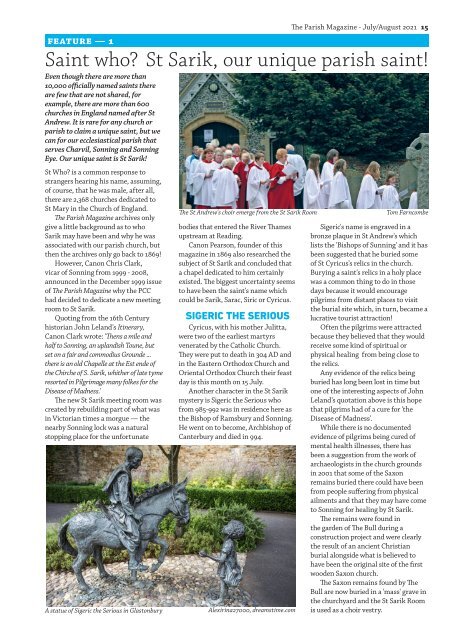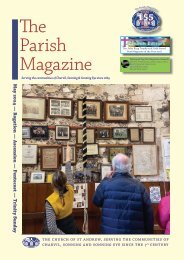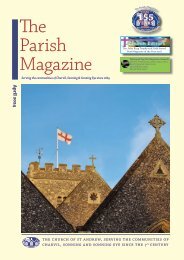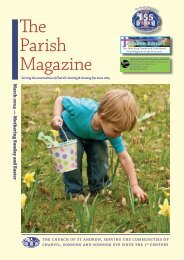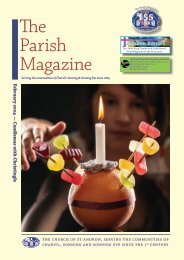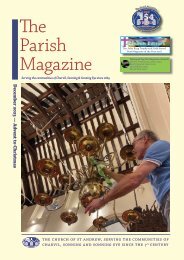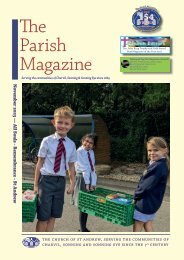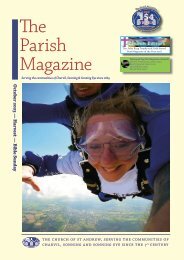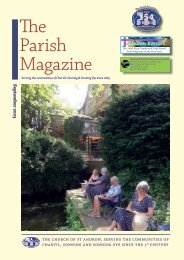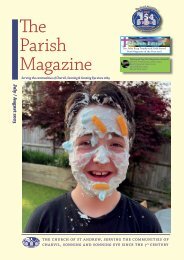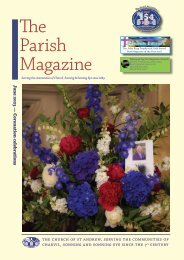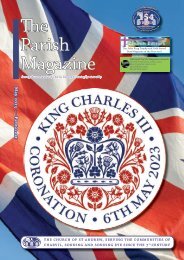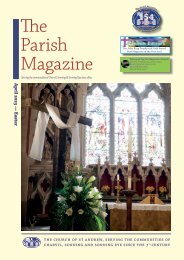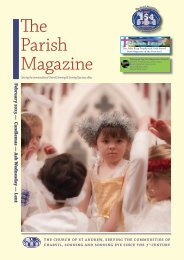The Parish Magazine July and August 2021
Serving the communities of Charvil, Sonning and Sonning Eye since 1869
Serving the communities of Charvil, Sonning and Sonning Eye since 1869
Create successful ePaper yourself
Turn your PDF publications into a flip-book with our unique Google optimized e-Paper software.
feature — 1<br />
Even though there are more than<br />
10,000 officially named saints there<br />
are few that are not shared, for<br />
example, there are more than 600<br />
churches in Engl<strong>and</strong> named after St<br />
Andrew. It is rare for any church or<br />
parish to claim a unique saint, but we<br />
can for our ecclesiastical parish that<br />
serves Charvil, Sonning <strong>and</strong> Sonning<br />
Eye. Our unique saint is St Sarik!<br />
St Who? is a common response to<br />
strangers hearing his name, assuming,<br />
of course, that he was male, after all,<br />
there are 2,368 churches dedicated to<br />
St Mary in the Church of Engl<strong>and</strong>.<br />
<strong>The</strong> <strong>Parish</strong> <strong>Magazine</strong> archives only<br />
give a little background as to who<br />
Sarik may have been <strong>and</strong> why he was<br />
associated with our parish church, but<br />
then the archives only go back to 1869!<br />
However, Canon Chris Clark,<br />
vicar of Sonning from 1999 - 2008,<br />
announced in the December 1999 issue<br />
of <strong>The</strong> <strong>Parish</strong> <strong>Magazine</strong> why the PCC<br />
had decided to dedicate a new meeting<br />
room to St Sarik.<br />
Quoting from the 16th Century<br />
historian John Lel<strong>and</strong>'s Itinerary,<br />
Canon Clark wrote: '<strong>The</strong>ns a mile <strong>and</strong><br />
half to Sonning, an upl<strong>and</strong>ish Toune, but<br />
set on a fair <strong>and</strong> commodius Grounde ...<br />
there is an old Chapelle at the Est ende of<br />
the Chirche of S. Sarik, whither of late tyme<br />
resorted in Pilgrimage many folkes for the<br />
Disease of Madness.'<br />
<strong>The</strong> new St Sarik meeting room was<br />
created by rebuilding part of what was<br />
in Victorian times a morgue — the<br />
nearby Sonning lock was a natural<br />
stopping place for the unfortunate<br />
bodies that entered the River Thames<br />
upstream at Reading.<br />
Canon Pearson, founder of this<br />
magazine in 1869 also researched the<br />
subject of St Sarik <strong>and</strong> concluded that<br />
a chapel dedicated to him certainly<br />
existed. <strong>The</strong> biggest uncertainty seems<br />
to have been the saint's name which<br />
could be Sarik, Sarac, Siric or Cyricus.<br />
SIGERIC THE SERIOUS<br />
Cyricus, with his mother Julitta,<br />
were two of the earliest martyrs<br />
venerated by the Catholic Church.<br />
<strong>The</strong>y were put to death in 304 AD <strong>and</strong><br />
in the Eastern Orthodox Church <strong>and</strong><br />
Oriental Orthodox Church their feast<br />
day is this month on 15 <strong>July</strong>.<br />
Another character in the St Sarik<br />
mystery is Sigeric the Serious who<br />
from 985-992 was in residence here as<br />
the Bishop of Ramsbury <strong>and</strong> Sonning.<br />
He went on to become, Archbishop of<br />
Canterbury <strong>and</strong> died in 994.<br />
<strong>The</strong> <strong>Parish</strong> <strong>Magazine</strong> - <strong>July</strong>/<strong>August</strong> <strong>2021</strong> 15<br />
Saint who? St Sarik, our unique parish saint!<br />
A statue of Sigeric the Serious in Glastonbury<br />
<strong>The</strong> St Andrew's choir emerge from the St Sarik Room<br />
Alexirina27000, dreamstime.com<br />
Tom Farncombe<br />
Sigeric's name is engraved in a<br />
bronze plaque in St Andrew's which<br />
lists the 'Bishops of Sunning' <strong>and</strong> it has<br />
been suggested that he buried some<br />
of St Cyricus's relics in the church.<br />
Burying a saint's relics in a holy place<br />
was a common thing to do in those<br />
days because it would encourage<br />
pilgrims from distant places to visit<br />
the burial site which, in turn, became a<br />
lucrative tourist attraction!<br />
Often the pilgrims were attracted<br />
because they believed that they would<br />
receive some kind of spiritual or<br />
physical healing from being close to<br />
the relics.<br />
Any evidence of the relics being<br />
buried has long been lost in time but<br />
one of the interesting aspects of John<br />
Lel<strong>and</strong>'s quotation above is this hope<br />
that pilgrims had of a cure for 'the<br />
Disease of Madness'.<br />
While there is no documented<br />
evidence of pilgrims being cured of<br />
mental health illnesses, there has<br />
been a suggestion from the work of<br />
archaeologists in the church grounds<br />
in 2001 that some of the Saxon<br />
remains buried there could have been<br />
from people suffering from physical<br />
ailments <strong>and</strong> that they may have come<br />
to Sonning for healing by St Sarik.<br />
<strong>The</strong> remains were found in<br />
the garden of <strong>The</strong> Bull during a<br />
construction project <strong>and</strong> were clearly<br />
the result of an ancient Christian<br />
burial alongside what is believed to<br />
have been the original site of the first<br />
wooden Saxon church.<br />
<strong>The</strong> Saxon remains found by <strong>The</strong><br />
Bull are now buried in a 'mass' grave in<br />
the churchyard <strong>and</strong> the St Sarik Room<br />
is used as a choir vestry.


